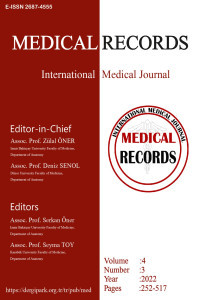GUİLLAİN-BARRE SENDROMLU HASTALARDA KLİNİK SEYİR VE PROGNOZ İLE İLİŞKİLİ FAKTÖRLERİN DEĞERLENDİRİLMESİ
Guillain-Barre sendromu, prognostik faktörler, klinik seyir
Evaluation of Factors Associated with the Clinical Course and Prognosis of Patients with Guillain-Barre Syndrome
Guillain-Barré syndrome, prognostic factors, clinical course,
___
- 1. Sejvar JJ, Baughman AL, Wise M, Morgan OW. Population incidence of Guillain-Barré syndrome: a systematic review and meta-analysis. Neuroepidemiology. 2011;36:123-33.
- 2. Head VA, Wakerley BR. Guillain–Barré syndrome in general practice: clinical features suggestive of early diagnosis. Br J Gen Pract. 2016;66:218-19.
- 3. Dalakas MC. Pathogenesis of immune-mediated neuropathies. Biochim Biophys Acta. 2015;1852:658-66.
- 4. Willison HJ, Jacobs BC, van Doorn PA. Guillain-barre syndrome. Lancet. 2016;388:717-27.
- 5. Piccione EA, Salame K, Katirji B. Guillain-Barré syndrome and related disorders. In: Katirji B, Kaminski H, Ruff R, eds, Neuromuscular Disorders in Clinical Practice. New York: Springer. 2014:573-603.
- 6. Leonhard SE, Mandarakas MR, Gondim FA et al. Diagnosis and management of Guillain–Barré syndrome in ten steps. Nat Rev Neurol. 2019;15:671- 83.
- 7. Zhang Y, Zhao Y, Wang Y. Prognostic factors of Guillain-Barré syndrome: a 111-case retrospective review. Chin Neurosurg. 2018;4:1-9.
- 8. Walgaard C, Lingsma H, Ruts L, et al: Early recognition of poor prognosis in Guillain-Barre syndrome. Neurology. 2011;76:968-75.
- 9. Asbury AK, Cornblath DR. Assessment of current diagnostic criteria for Guillain‐Barré syndrome. Ann Neurol. 1990;27:21-4.
- 10. Hughes R, Newsom-Davis J, Perkin GD, Pierce JM: Controlled trial of prednisolone in acute polyneuropathy. Lancet. 1978;312:750-53.
- 11. Sipilä JO, Soilu‐Hänninen M, Ruuskanen JO, et al. Epidemiology of Guillain‐Barré syndrome in Finland 2004–2014. J Peripher Ner Syst. 2017;22:440-45.
- 12. McGrogan A, Madle GC, Seaman HE, De Vries CS. The epidemiology of Guillain-Barré syndrome worldwide. Neuroepidemiology. 2009;32:150-63.
- 13. Khan F, Pallant J, Ng L, Bhasker A. Factors associated with long-term functional outcomes and psychological sequelae in Guillain–Barre syndrome. J Neurol. 2010;257:2024-31.
- 14. Sudulagunta SR, Sodalagunta MB, Sepehrar M, et al. Guillain-Barré syndrome: clinical profile and management. Ger Med Sci. 2015;13:Doc16.
- 15. Webb AJ, Brain SA, Wood R, et al. Seasonal variation in Guillain-Barré syndrome: a systematic review, meta-analysis and Oxfordshire cohort study. J Neurol, Neurosurg, Psychiatry.2015; 86:1196-201.
- 16. Rocha MSG, Brucki SMD, Carvalho AAdS, et al. Epidemiologic features of guillain- barré syndrome in São Paulo, Brazil. Arq Neuropsiquiatr. 2004;62:33-7.
- 17. Ozbey G, Tasdemir BJVi: Seasonality and antibiotic resistance of Campylobacter in Turkish chicken meat. Vet Ital. 2014;50:277-83.
- 18. Mathew T, Srinivas M, Nadig R, Arumugam R, Sarma GRK. Seasonal and monthly trends in the occurrence of Guillain-Barre syndrome over a 5-year period: A tertiary care hospital-based study from South India. Ann Indian Acad Neurol. 2014;17:239-41.
- 19. Meşe S, Uyanik A, Özakay A, et al. Influenza surveillance in Western Turkey in the era of quadrivalent vaccines: A 2003–2016 retrospective analysis. Hum Vaccin Innunother. 2018;14:1899-908.
- 20. Çetiner M, Seyit M, Akdağ G, et al. Guillain-Barré Sendromlu Hastalarda Prognozla İlişkili Faktörler. Turk J Neurol. 2019;25:140-45.
- 21. Gazioglu S, Tomak T, Boz C. Guillain Barre Sendromunda Klinik Özellikler ve Prognoz. J Neurol Sci. 2013;30:124-34.
- 22. Tam CC, O’Brien SJ, Petersen I, Islam A, Hayward A, Rodrigues LC. Guillain-Barré syndrome and preceding infection with campylobacter, influenza and Epstein-Barr virus in the general practice research database. PLoS One. 2007;2:e344.
- 23. Arami MA, Yazdchi M, Khandaghi R. Epidemiology and characteristics of Guillain-Barre syndrome in the northwest of Iran. Annals of Saudi Medicine. 2006;26:22-7.
- 24. Eşref A, Varol S, Taşkın A, Arıkanoğlu A, Tamam Y, Öztürk Ü. Guillain-Barre sendromunda klinik ve demografik özellikler. Dicle Medical Journal. 2014;41:707- 11.
- 25. Tian J, Cao C, Li T, Zhang K, Li P, Liu Y, Liu X. Electrophysiological subtypes and prognostic factors of Guillain-Barre syndrome in northern china. Frontiers in Neurology. 2019;10:714.
- 26. Rajabally YA, Uncini A. Outcome and its predictors in Guillain–Barré syndrome. Journal of Neurology, Neurosurgery, Psychiatry. 2012;83:711-8.
- 27. Wang Y, Lang W, Zhang Y, Ma X, Zhou C, Zhang H-L. Long-term prognosis of Guillain- Barré syndrome not determined by treatment options? Oncotarget.2017;8:79991.
- 28. Fletcher DD, Lawn ND, Wolter TD, Wijdicks EF. Long-term outcome in patients with Guillain–Barré syndrome requiring mechanical ventilation. Neurology. 2000;54:2311-5.
- 29. Hashim NA, Mohamed WS, Emad EM. Neutrophil–lymphocyte ratio and response to plasmapheresis in Guillain–Barré syndrome: a prospective observational study. The Egyptian Journal of Neurology, Psychiatry and Neurosurgery. 2020;56:17.
- Yayın Aralığı: Yılda 3 Sayı
- Başlangıç: 2019
- Yayıncı: Zülal ÖNER
Sacrum Kemiğinin Morfometrisi ve Varyasyonu
Gökçe BAĞCI UZUN, Merve AYDIN, Burcu KAMAŞAK, Büşra ZENCİRCİ, Tufan ULCAY, Mehtap NİSARİ, Hıdır PEKMEZ
Cerrahi Rezeksiyon Gerektiren Transvers Kolon Yerleşimli Pnömatozis Sistoides İntestinalis Olgusu
Baris GORGUN, Atilla Süleyman DİKİCİ, Hüseyin BOTANLIOĞLU, Fatih KANTARCI, Muharrem INAN
Mehmet Emin PARLAK, Atike ATALAY, Aygen YILMAZ
Long-Term Results of Tragal Cartilage Type 1 Tympanoplasty
Fatih YÜCEDAĞ, Ergün SEVİL, İsmail ÇEVİK
Adult Onset Langerhans Cell Histiocytosis: A Single Center Experience
Serhat ÇELİK, Zeynep Tuğba GÜVEN, Onur AŞIK, Muzaffer KEKLİK, Leylagül KAYNAR, Bülent ESER, Mustafa ÇETİN, Ali ÜNAL
Identification of Neutrophil/Lymphocyte Ratio as a Unique Biomarker for Migraine Follow-up
Elif UYGUR KUCUKSEYMEN, Gızem AKCA
Cemil ÇOLAK, Ahmet Kadir ARSLAN, Hasan UCUZAL, Adem KÖSE, İsmail Okan YILDIRIM, Emek GÜLDOĞAN, Mehmet Cengiz ÇOLAK
Anxiety Status in Parents of Infants Referred During National Newborn Hearing Screening
Emre SÖYLEMEZ, Engin KARABOYA, Süha ERTUĞRUL, Nihat YILMAZ, Ahmet KİZMAZ, Muhammed Harun BAYRAK, Abdulkadir ILGAZ
